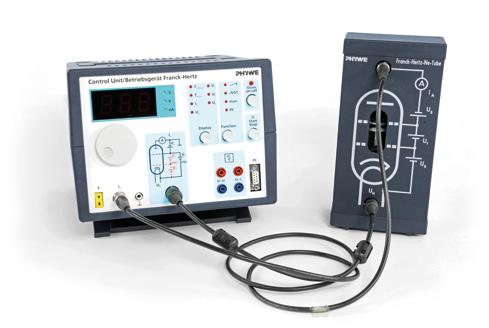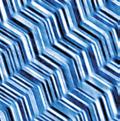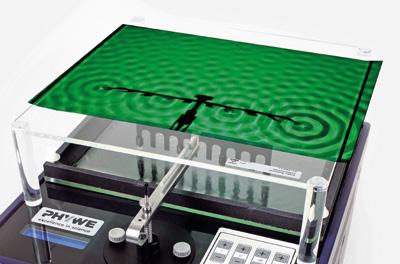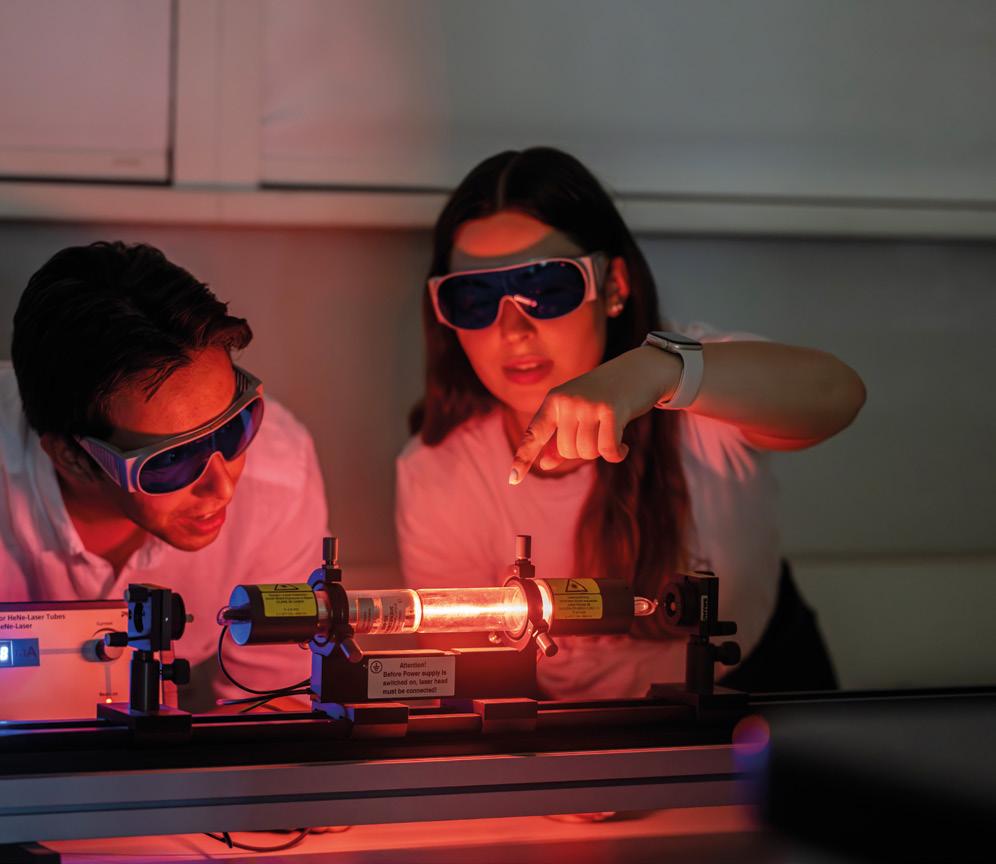

NOBEL PRIZE

PREMIUM EXPERIMENTS
Nobel Prize-Worthy Discoveries for Classrooms





Nobel Prize-Worthy Discoveries for Classrooms

For over a century, the Nobel Prizes have symbolized groundbreaking discoveries and outstanding achievements in science. The laureates, through their profound knowledge and dedication, have shaped our modern understanding of the natural world and driven forward the frontiers of scientific knowledge. With PHYWE’s Premium Experiments, you have the opportunity to delve into the fascinating world of these revolutionary discoveries and explore the principles behind the award-winning research in a hands-on and engaging way.
At PHYWE, we bring these Nobel Prize-worthy discoveries into classrooms and laboratories with our expertly designed experimental set-ups. Whether in physics, chemistry, biology, or medicine, our educational experiments allow complex scientific phenomena to be understood in an accessible and tangible manner. Students become active explorers, recreating the foundations and key concepts behind these monumental discoveries.
In this brochure, we present a selection of experiments inspired by the work of Nobel laureates and more premium experiments. Through practical, inquiry-based learning, students gain a deeper insight into scientific principles while experiencing firsthand the innovative spirit that drives






Nobel Prize in Physics 1901
Wilhelm Conrad Röntgen
“In recognition of the extraordinary services he has rendered by the discovery of the remarkable rays subsequently named after him”
X-ray Physics » Page 4
Nobel Prize in Physics 1918
Max Planck
“In recognition of the services he rendered to the advancement of Physics by his discovery of energy quanta”
Planck’s “Quantum of Action” and External Photoelectric Effect » Page 12


Nobel Prize in Physics 1925
James Franck and
Gustav Ludwig Hertz
“For their discovery of the laws governing the impact of an electron upon an atom”
Franck-Hertz Experiment » Page 10
1900 …
1901 Wilhelm C. Röntgen
1901 Jacobus H. van‘t Hoff
1902 Hendrik A. Lorentz, Pieter Zeeman
1903 Henri Becquerel, Pierre Curie, Marie Curie
1906 Joseph J. Thomson
1907 Albert A. Michelson
1908 Ernest Rutherford
1910 Johannes D. van der Waals
1911 Wilhelm Wien
1914 Max von Laue
1915 William H. Bragg, William L. Bragg
1917 Charles G. Barkla
1918 Fritz Haber
1918 Max Planck
1920 …
1920 Walther H. Nernst
1921 Albert Einstein
1922 Niels H. D. Bohr
1923 Robert A. Millikan
1924 Karl M. G. Siegbahn
1924 Willem Einthoven
1925 James Franck, Gustav L. Hertz
1927 Arthur H. Compton
1927 Charles T. R. Wilson
1929 Louis V. P. R. de Broglie

Nobel Prize in Physics 1943
Otto Stern


“For his contribution to the development of the molecular ray method and his discovery of the magnetic moment of the proton”
Stern-Gerlach Experiment » Page 11



1930 Karl Landsteiner
1931 Carl Bosch, Friedrich Bergius
1932 Werner K. Heisenberg
1932 Irving Langmuir
1936 Victor F. Hess, Carl D. Anderson
1936 Petrus J. W. Debye
1937 Clinton J. Davisson, George P. Thomson
Nobel Prize in Physics 1986 Heinrich Rohrer and Gerd Binnig
“For their design of the scanning tunneling microscope”
Nano Physics » Page 22
Nobel Prize in Physics 2009
Charles Kuen Kao
“For groundbreaking achievements concerning the transmission of light in fibers for optical communication”
Fiber Optics » Page 25


1943 Otto Stern
1945 Wolfgang E. Pauli
1948 Arne W. K. Tiselius
1952 Felix Bloch, Edward M. Purcell
1954 Max Born, Walther Bothe
1964 Charles H. Townes, Nikolay G. Basov, Alexander M. Prokhorov
1970 onwards
1971 Dennis Gabor
1979 Allan M. Cormack, Sir Godfrey N. Hounsfield
1985 Klaus von Klitzing
1986 Heinrich Rohrer, Gerd Binnig
2003 Paul C. Lauterbur, Sir Peter Mansfield
2009 Charles K. Kao
2009 Willard Boyle; George E. Smith




Tube XChange Technology
· Self-adjusting X-ray tubes with quick-change technology
· Contact protection against hot parts 4 anode materials for specific experiments (W, Mo, Cu, Fe)
Touch Panel
Simultaneous control, manually and by computer
Interactive, intuitive handling
Self-explanatory icons for fast operation
High-Resolution TFT Backlit Display
Diagonal 4,3", 480 × 272 pixels
16 bit, 65.536 colors
With LED lighting
Optimal, dynamic representation of all important device parameters and measured values
XXL Chamber
Large space for large experiments
· Temperature-controlled, internally ventilated experimentation space

Insight Provides a Transparent View
Exceptional Observability of the experimentation space
Extra-large window front on 3 sides (diagonals: 18"/18"/14", 46 cm/46 cm/36 cm)
Discover the fascinating world of X-ray physics with our basic X-ray set! Whether it’s exciting fluorescence experiments or stunning X-ray photography, the device offers everything you need to experience the fundamental principles up close. But that’s just the beginning: for those eager to dive deeper, our topic-specific upgrade sets open up even more possibilities.

They cover a wide range of fields – from physics and chemistry to biology, medicine, materials science, and geosciences. Whether in school or atuniversity, our device is an essential tool for modern education and meets the highest safety standards.
Get inspired – for the science of tomorrow!



S-Lock: New PHYWE Safety Interlock
Electrical and mechanical safety lock
Prevents door opening with switched on X-radiation
Thus offers the highest possible safety
Goniometer (not pictured)
Self-calibrating
Collision protected Easy, safe handling
Safekeeping Drawer
All accessories are kept safely and always ready at hand
Lockable

Expand your exploration of X-ray physics with our XR 4.0 Upgrade Sets, crafted to provide deeper insights into a variety of scientific fields. Each set empowers learners and researchers alike to engage with advanced concepts through hands-on experiments, paving the way for innovative discoveries and a richer understanding of the world around us.

Art. no. 09125-88
The “Solid-State Physics” upgrade set allows for in-depth investigations of the crystalline structure of solids through X-ray diffraction experiments. With this set, you can explore complex topics such as lattice constants and crystal structure analysis in a practical and engaging way.

Art. no. 09135-88
Our “X-ray Characteristics” upgrade set is used for the characterization of the radiation spectra of various different anode materials. It is particularly suitable for studying the fundamental principles of X-ray physics.

Art. no. 09165-88
The “Material Analysis” upgrade set offers advanced tools for examining the elemental composition and properties of different materials through X-ray fluorescence and absorption techniques. This set allows for precise, non-destructive analysis, making it ideal for research in material science and engineering.





Art. no. 09145-88
Our “Structure Analysis” upgrade set enables detailed investigation of the atomic and molecular structures of materials using X-ray diffraction techniques. It is perfect for exploring crystallography and gaining insights into the internal arrangement of atoms in solids, essential for material science research.
Art. no. 09155-88
The “Imaging” upgrade set allows for the visualization of internal structures of objects through X-ray imaging. This set is ideal for non-destructive testing and analysis, providing detailed insights into the hidden features of various materials and components.
Art. no. 09175-88
Our “Dosimetry” upgrade set is particularly suitable for studying the dosimetry in qualitative and quantitative way. It enables the study of radiation doses, making it ideal for applications in medicine, radiology and biology.
Art. no. 09185-88
The “Computed Tomography” upgrade set allows for 3D imaging and detailed internal visualization of objects using X-ray technology.
This set is perfect for exploring non-destructive analysis techniques, providing comprehensive insights into the internal structure of various materials.





PHYWE’s diffusion cloud chambers are suitable for observing natural ionizing radiation: cosmic radiation and the natural radioactivity of the earth. The ever-changing patterns of both types of natural radiation can be observed simultaneously thanks to the large observation area.
When a charged particle (like an α- or β-particle) passes through the chamber, it ionizes the surrounding gas. The vapor condenses around these ionized particles, forming tiny droplets that trace the particle’s path. These visible trails reveal the motion and interaction of subatomic particles, providing insight into radiation and particle physics. The diffusion cloud chamber offers the opportunity to carry out physical experiments with the aid of artificial radiation sources.

· Perfect for walk-around displays in science centers
· Only instrument to visualize charged particles (beta) and cosmic radiation (mesons, myons)
· Easy differentiation between α-particle, β-particle, protons, myons, electrons and positrons

Art. no. 09043-93
Natural Radioactivity
Cosmic Radiation
Ionising Particles, Mesons
· Radioactive Decay Lorentz Force


Art. no. 09046-93

The MiniPIX single photon counter is a compact particle detector that uses a pixelated semiconductor sensor to detect individual photons or charged particles. Each pixel in the sensor is capable of counting and recording the energy deposited by incoming particles, allowing precise detection at a very high resolution. MiniPIX can distinguish between different types of radiation (such as X-rays, γ-radiation, or α- and β-particles) based on their energy levels.
This makes it highly useful in fields like radiation monitoring, medical imaging, and particle physics, where precise detection and imaging of ionizing radiation is essential.

· Particle Detection Energy Measurement

The Franck-Hertz experiment is a key milestone in quantum physics, demonstrating the existence of discrete energy states in atoms. This experiment makes it possible to visualize quantized energy transitions through electron collisions.
At PHYWE, we offer both the classic version with a mercury tube and a modern alternative with neon. The neon atoms emit light as they return to their ground state, producing visible spectral lines. Both versions allow for the exploration of fundamental principles of atomic physics and the behavior of electrons at different energy levels—perfect for educational use in schools and universities.

Quantization of Atomic Energy Levels
Electron-Atom Collisions
Inelastic Electron Collisions
· Excitation Energy Energy Transitions

Franck-Hertz Experiment with a Hg-Tube Art. no. P2510311


experiment


Franck-Hertz Experiment with a Ne-Tube Art. no. P2510315
Retrace the First Proof of Quantisation of the Angular Momentum of an Atom
A beam of potassium atoms generated in a hot furnace travels along a specific path in a magnetic two-wire field. Because of the magnetic moment of the potassium atoms, the non-homogeneity of the field applies a force at right angles to the direction of their motion.
The potassium atoms are thereby deflected from their path. By measuring the density of the beam of particles in a plane of detection lying behind the magnetic field, it is possible to draw conclusions as to the magnitude and direction of the magnetic moment of the potassium atoms.


· Quantization of Angular Momentum
Spin and Magnetic Moments
Spatial Quantization
Bohr Magneton
· Atomic Beam

Ionization current as a function of position (u) of detector with large excitation currents in the magnetic analyser



Quantization of Light Energy and Photons
External Photoelectric Effect in Quantum Theory
Measurement of Planck’s Constant Photon Energy
Absorption
These experiments provide a clear demonstration of fundamental quantum physics concepts, particularly the quantized nature of light and the transfer of energy through photons. Both versions aim to investigate Planck’s quantum of action and the external photoelectric effect, using different methods to separate spectral lines.


In the first version, interference filters are used to selectively isolate specific wavelengths of light, allowing precise measurement of photon energy. This method provides an accurate study of quantized energy transfer in the photoelectric effect. In the second version, spectral lines are separated using a diffraction grating. This alternative approach effectively demonstrates the splitting of light into its component wavelengths, enabling a detailed analysis of the photoelectric effect and the calculation of Planck’s constant.
Both approaches offer valuable insights into quantum mechanics and illustrate how light transfers energy to electrons in the form of photons, a phenomenon that significantly contributed to the development of modern physics.
Planck’s “Quantum of Action” and Photoelectric Effect (Line Separation by Interference Filters)
Art. no. P2510402

Planck’s “Quantum of Action” and External Photoelectric Effect Art. no. P2510511
· Semiconductors
Band Theory
Intrinsic and Extrinsic Conductivity
Magnetic Resistance
Hall Coefficient
The Hall Effect experiment demonstrates the behavior of electric charges in a conductor or semiconductor when exposed to a magnetic field.
In the experiment, a current is passed through a thin strip of material, and a perpendicular magnetic field is applied. This causes the moving charge carriers (electrons or holes) to experience a force, known as the Lorentz force, which deflects them to one side of the material. As a result, a voltage difference, called the Hall Voltage, develops across the sides of the strip.


This Hall voltage is proportional to the magnetic field strength and helps determine properties like the type of charge carriers and their concentration in the material.


LEARNING OBJECTIVES


The irradiation of iodine, barium (sulfat), silver and tin with -radiations gives rise to Kα radiations characteristics of
The X-ray spectra are recorded with a γ-spectrometer consisting of a scintillation counter, a pulse height analyser and a recorder. After calibration of the spectrometer, the Rydberg constant is determined from the energies of the X-ray lines, using Moseley’s law.


When photons e.g. γ-radiation collide with electrons in a material, they transfer some of their energy to the electrons, causing the photons to scatter at different angles. The scattered photons have a longer wavelength (lower energy) compared to the incoming photons. This change in wavelength, called the Compton Shift, can be determined and it depends on the scattering angle.
The experiment confirmed that light behaves as photons with quantized energy, supporting quantum theory and provides evidence for the dual nature of electromagnetic radiation.

Compton Effect with the Multichannel Analyser
Art. no. P2524415
X-Ray Fluorescence and Moseley’s Law
Art. no. P2524715
OBJECTIVES
Corpuscle

The “Zeeman Effect” is the splitting up of the spectral lines of atoms within a magnetic field. The simplest is the splitting up of one spectral line into three components called the “normal Zeeman effect”.
In this experiment the normal Zeeman effect as well as the anomalous Zeeman effect are studied using a cadmium spectral lamp as a specimen. The cadmium lamp is submitted to different magnetic flux densities and the splitting up of the cadmium lines is investigated using a Fabry-Perot interferometer. The evaluation of the results leads to a precise value for Bohr’s magneton.
This experiment is also available with an electromagnet.

Bohr’s Atomic Model and Bohr’s Magneton
Quantisation of Energy Levels
Electron Spin
Interference of Electromagnetic Waves
Fabry-Perot Interferometer


Zeeman Effect with a Variable Magnetic System
Art. no. P2511010


Zeeman Effect with Electromagnet
Art. no. P2511009
The quantum eraser experiment demonstrates how observation affects quantum behavior. When photons pass through a double slit, they form an interference pattern, showing wave-like behavior. If the “which-path” information is known,
the interference disappears, revealing particle-like behavior. However, by “erasing” this information using entangled photons, the interference pattern returns, showing that the act of observation influences the outcome, even retroactively.

Quantum Mechanics
Wave particle Duality
· Inteference Patterns
Quantum Entanglement Principles
· „Which-Path“ Information vs. Interference

Quantum Eraser Art. no. P2220811
Principles of Interference and Superpostition
Wavelength of Light
Optical Path Difference and Coherence
Application of Interferometry in Precise Measurements
Speed of Light
The Michelson interferometer experiment measures precise length changes by exploiting interference. A beam of light is split into two perpendicular paths using a beam splitter. Each beam reflects off mirrors and then recombines at the beam splitter. The combined light creates an interference pattern, which shifts if there are changes in the path lengths.
By analyzing these shifts, the interferometer can detect minute changes in distance or measure wavelength differences with high precision. This technique is widely used in various applications, including gravitational wave detection and optical measurements.


Michelson Interferometer – High Resolution
Art. no. P2220911

The Rutherford gold foil experiment is part of a landmark series of experiments by which scientists discovered that every atom contains a nucleus where its positive charge and most of its mass are concentrated. In order to obtain maximum possible counting rates, the Chadwick Geometry is used where the scattering angle is varied over a wide range by moving foil and source.


Rutherford Experiment Art. no. P2522115
LEARNING OBJECTIVES
Electric Field
Viscosity
· Stokes’ Law
Droplet Method
Electron Charge

PRIZE 1923

Elementary Charge and Millikan Experiment
Art. no. P2510100
LEARNING OBJECTIVES
· Scattering Experiment
Rutherford Atomic Model
Scattering Angles
Coulomb Field
· Nuclear Structure

PRIZE 1908
Charged oil droplets subjected to an electric field and to gravity between the plates of a capacitor are accelerated by application of a voltage. The elementary charge is determined from the velocities



Cathode Rays
· Lorentz Force
Electron in Crossed Fields
Electron Mass
Electron Charge
The experiment to determine the specific charge of the electron (e/m) measures the ratio of the electron’s charge (e) to its mass (m). In this experiment, electrons are accelerated through an electric field and then pass through a magnetic field. The magnetic field causes the electrons to travel in a circular path. By measuring the radius of this path and knowing the magnetic field strength, the velocity of the electrons can be determined.
Using these measurements, the specific charge can be calculated. This experiment provides fundamental insights into the properties of electrons and is crucial for understanding atomic and particle physics.

Specific Charge of the Electron – e/m Art. no. P2510200
Coulomb’s Law and Electrostatic Interactions
Coulomb Potential
Electric Field
· Charge Distribution
Image Charge

The Coulomb Potential experiment involves charging conducting spheres of different diameters and measuring their electric fields and potentials Using an electric field meter equipped with a potential measuring probe, the static electric potentials and field intensities are determined as functions of position and voltage.
The experiment is computer-assisted, allowing precise measurements of how the electric potential varies with distance from the charged spheres and how it relates to the applied voltage. This setup demonstrates the principles of Coulomb’s Law, showing how electric potential and field strength depend on the charge and size of the conducting spheres.
Discover curricuLAB®
Check out our digital descriptions for all our experiments: Explore comprehensive information and interactive elements that enhance your understanding!

Coulomb Potential and Coulomb Field of Metal Spheres
Art. no. P2420505


Fully functional Magnetic Resonance Tomograph (MRT) for teaching purposes, covering all aspects from the basic principles of Nuclear Magnetic Resonance (NMR) to the high-resolution 2D and 3D MR imaging (MRI). The system gives you the unique opportunity of offering training at a real MRT machine in the student lab. In order to provide for realistic and practice-oriented nuclear magnetic resonance (NMR) training for all fields of science and medicine.
The training software makes it easy for the users to experience all aspects of magnetic resonance tomography. The following imaging procedures can be performed: spin-echo 2D, flash 2D, localized spin echo 2D, spin echo 3D.
Nuclear Spins; Atomic Nuclei with a Magnetic Moment
Precession of Nuclear Spins; Magnetisation
Resonance Condition, MR Frequency
FID Signal (Free Induction Decay)
· Spin Echo





Approaching a very sharp metal tip to an electrically conductive sample by applying an electrical field leads to a current between tip and sample without any mechanical contact. This so-called tunneling current is used to
investigate the electronic topography on the sub-nanometer scale of a fresh prepared graphite (HOPG) surface. By scanning the tip line-by-line across the surface graphite atoms and the hexagonal structure are imaged.






Microstructures

OBJECTIVES
Tunneling Effect
Imaging on the Sub-Nanometer Scale
Piezo-Electric Devices
Local Density of States (LDOS)
Hexagonal Structures
Atomic Resolution of the Graphite Surface by STM (Scanning Tunneling Microscope)
Art. no. P2532000
The PHYWE Compact Atomic Force Microscope (AFM) is a cuttingedge tool designed for educational and research environments, bringing the power of nanoscale imaging and measurement to your laboratory. Utilizing advanced AFM technology, this compact instrument allows users to explore surface topography and mechanical properties with exceptional resolution.
With its user-friendly interface, the PHYWE Compact AFM is ideal for both students and researchers. It provides hands-on experience in nanoscale analysis, fostering a deeper understanding of material science, physics, and biology. Its portability makes it perfect for educational institutions, enabling the integration of advanced microscopy techniques into the curriculum without the need for bulky equipment.
· Static Mode, Dynamic Mode
Imaging on the Micrometer Scale
Lennard-Jones Potential
Magnetic Force Microscopy
Phase Contrast Imaging





Easy to operate: just switch on the instrument, add water and start! The PHYWE ripple tank is an easy to use, virtually soundless and compact device which allows demonstrative and quantitative access to wave mechanics principles.
The frequency range of 5 to 60 Hz with variable amplitudes covers all necessary frequencies to perform demonstration and lab course experiments both at schools and universities.
Principles of Wave Behavior
· Reflection, Refraction and Diffraction
Wave Interactions and Interference Patterns
Wavelength, Frequency and Wave Speed
Doppler Effect
With the PHYWE Ripple tank you can realize qualitative and quantitative results within a very short time. With the optional available external vibration generator (article no. 11260-10) it is possible to demonstrate interference phenomena or the Doppler effect.




PHYWE’s experiment for measuring the speed of light allows students to explore this essential constant using a coherent light source and advanced measurement devices.
Participants accurately determine the speed of light through various media, demonstrating its significance in modern physics and technologies like telecommunications and GPS. This hands-on experience fosters critical thinking and practical skills while enhancing appreciation for the scientific process.
· Principles of Light
Propagation
Refractive Index
· Wavelength, Frequency and Phase Modulation
Electric Field Constant
· Magnetic Field Constant


LEARNING OBJECTIVES
· Total Reflection
Gaussian Beam
Monomode and Multimode Fibre
Velocity of Light
Transverse and Longitudinal Modes


The fiber optics experiment demonstrates total reflection in optical fibers. A laser diode beam is coupled into a monomode fiber, and the challenges of this coupling are evaluated.

A low-frequency signal is transmitted, and the fiber’s numerical aperture is recorded. The transit time of light is measured to determine its velocity, while measuring the diode laser’s output power relative to supply current reveals its “threshold energy” and “slope efficiency.”
The helium-neon (He-Ne) laser experiment demonstrates the principle of laser operation using a gas mixture of helium and neon. In this setup, an electric current excites helium atoms, which then transfer energy to neon atoms through collisions. The neon atoms, in an excited state, emit photons when they return to a lower energy level. These photons stimulate other excited neon atoms to emit more photons, creating a coherent beam of light.

Helium-Neon Laser
Art. no. P2260701
The laser’s optical cavity, composed of two mirrors, amplifies and directs this beam, producing a highly focused and monochromatic light beam. This experiment illustrates the fundamentals of laser technology, including spontaneous and stimulated emission and optical amplification.
· Spontaneous and Stimulated Light Emission

Resonator Cavity
· Gas Discharge Tube
Collision of Second Type
Brewster Angle


LEARNING OBJECTIVES
· Thermal Tension Coefficient
General Equation of State for Ideal Gases
· Universal Gas Constant Amontons’ Law
Relation between Temperature, Pressure and Volume
Demonstrate the Temperature and the Kinetic Theory of Gases
The state of a gas is determined by temperature, pressure and volume. For the limiting case of ideal gases, these state variables are linked via the general equation of state. For a change of state under isochoric conditions this equation becomes Amontons’ Law.
In this experiment it is investigated whether Amontons’ Law is valid for a constant amount of gas (air). With this compact experiment setup all three gas laws can be performed. The experiment provides a simplified model that helps to predict the behavior of gases under various conditions.

Equation of State for Ideal Gases (Gas Laws: Gay-Lussac, Amontons, Boyle)
Art. no. P2320167
By means of the model apparatus for kinetic theory of gases the motion of gas molecules is simulated and the velocities determined by registration of the throw distance of the glass balls.
LEARNING OBJECTIVES
Kinetic Theory of Gases
Kinetic Energy
Average Velocity
Gas Molecules
Velocity Distribution

Maxwell-Boltzmann
Velocity Distribution
Art. no. P2320300

The experiment on the heat capacity of metals using the Cobra SmartSense system allows students to explore the thermal properties of various metals.
Students measure how different metals respond to heat, determining their specific heat capacities and understanding their ability to absorb and store thermal energy.


Heat Capacity of Metals with Cobra SMARTsense
Art. no. P2330167
LEARNING OBJECTIVES
Mixture Temperature
· Boiling Point
Dulong Petit’s Law
Internal Energy
Debye Temperature
The PHYWE RLC circuit experiment provides a detailed exploration of the principles governing electrical circuits containing resistors (R), inductors (L), and capacitors (C). This hands-on experiment enables students to analyze the behavior of RLC circuits in both series and parallel configurations, focusing on key concepts such as resonance, impedance, and energy storage.
Students will connect circuit components and utilize measurement tools to observe the effects of varying frequencies on voltage and current. By studying the phase relationships between voltage and current in different circuit configurations, students gain insight into the reactive nature of inductors and capacitors and how they influence circuit dynamics.
· Fundamentals of RLC Circuits
Resonance Phenomena
· Impedance
Voltage and Current
Phase Relationsips
· Circuit Assembly


The Stirling Engine experiment using digital data acquisition provides an engaging way to explore thermodynamic principles and heat engines. Students observe the operation of a Stirling Engine, which converts thermal energy into mechanical work through the cyclic compression and expansion of gas.
The students capture real-time data on temperature changes and engine performance, gaining insights into the engine’s efficiency and functionality. This hands-on experience enhances their understanding of heat transfer and energy conversion while developing practical skills in data collection and analysis.
The experiment effectively combines classic thermodynamics with modern measurement techniques, making it an excellent educational tool.
· First and Secondary Law of Thermodynamics
Reversible Cycles
· Isochoric and Isothermal Changes
Efficiency
· Conversion of Heat



Action Potential
Different Types of Synapses
Synaptic Learning and Forgetting
Conditioned Reflex
Motoneuron

The experiment on the interaction of nerve cells provides an engaging way to study neurobiology and the signaling mechanisms between nerve cells. Students can observe and analyze electrical activity, measuring action potentials and synaptic responses in real time.
This hands-on experience enhances the understanding of neuronal communication while developing practical skills in electrophysiology. The integration of modern technology with neurobiological concepts makes this experiment an effective educational tool.
Measurement of conditioned reflex


Nerve Cell Interactions with Cobra SMARTsense
Art. no. P4010869

With over a century of experience, PHYWE leads in science education, offering customized solutions for educators worldwide. Based in Germany, our integrated approach promotes engaging and effective scientific learning.
Focused on quality and sustainability, we collaborate with over 110 organizations in 120 countries to empower learners and teachers. Our didactic systems are designed with educators to fit diverse curricula.
The Lucas-Nülle Education Group, including Lucas-Nülle and PHYWE, offers comprehensive education solutions. We create unique didactic systems for schools and vocational training, providing flexible options for institutions from primary schools to technical universities. Committed to respect, integrity, and social responsibility, we deliver high-quality educational experiences tailored to learners’ needs.
Active engagement is essential for true learning. By connecting the didactic solutions of Lucas Nülle and PHYWE, our hands-on methodology Real Experience Learning helps learners develop practical skills. This integration of theory and practice empowers students to grasp and apply scientific concepts, preparing them for future challenges.
Our Solutions for More Customer Satisfaction
. Technical trainings for customers and International Sales Partners (ISP)
. International training weeks
. Technical hotline
. Email support
. Online product trainings
Online webinars
YouTube product videos (pre-sales/after-sales)
Consulting
Curricula-based quotations
. Online orders
. Project planning, tender support
. Product introduction seminars
Newsletters

Installation and implementation
. On-site trainings by PHYWE staff
. Turn-key project management
. Warranty, repairs and spare parts
Follow-up trainings

The awarded teaching and learning platform for natural sciences provides interactive digital descriptions for all our experiments. Register now to gain 180 days of free access to over 2,000 detailed experiment descriptions across various scientific fields!

